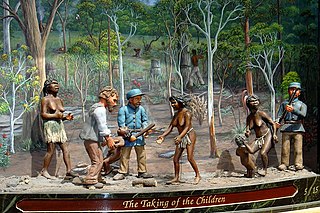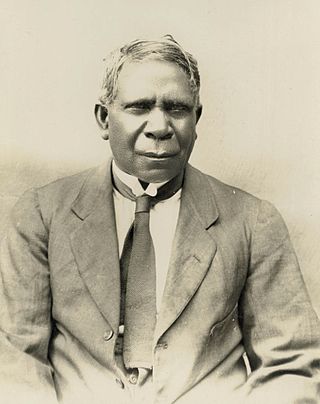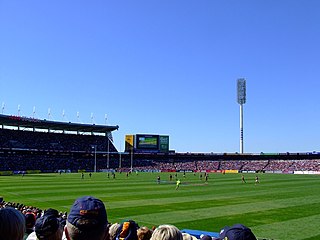Related Research Articles

The Stolen Generations were the children of Australian Aboriginal and Torres Strait Islander descent who were removed from their families by the Australian federal and state government agencies and church missions, under acts of their respective parliaments. The removals of those referred to as "half-caste" children were conducted in the period between approximately 1905 and 1967, although in some places mixed-race children were still being taken into the 1970s.
The Wiradjuri people are a group of Aboriginal Australian people from central New South Wales, united by common descent through kinship and shared traditions. They survived as skilled hunter-fisher-gatherers, in family groups or clans, and many still use knowledge of hunting and gathering techniques as part of their customary life.

Australian culture is of primarily Western origins, and is derived from its British, Indigenous and migrant components.

The Noongar are Aboriginal Australian people who live in the south-west corner of Western Australia, from Geraldton on the west coast to Esperance on the south coast. There are 14 different groups in the Noongar cultural bloc: Amangu, Ballardong, Yued, Kaneang, Koreng, Mineng, Njakinjaki, Njunga, Pibelmen, Pindjarup, Wadandi, Whadjuk, Wiilman and Wudjari. The Noongar people refer to their land as Noongar boodja.

David Ngunaitponi, known as David Unaipon, was an Aboriginal Australian preacher, inventor, and author. A Ngarrindjeri man, his contribution to Australian society helped to break many stereotypes of Aboriginal people, and he is featured on the Australian $50 note in commemoration of his work. He was the son of preacher and writer James Unaipon.

Football in Australia refers to numerous codes which each have major shares of the mainstream sports market, media, broadcasting, professional athletes, financial performance and grassroots participation: Australian rules football, rugby league, rugby union and soccer. There are four pre-eminent professional football competitions played in Australia: the Australian Football League, the National Rugby League, Super Rugby and the A-League (soccer). Rugby League is the most watched sport in Australia based on television viewership, however, Australian football attracts larger live attendences. In the states of New South Wales and Queensland, rugby football is overall the most watched and receives the most media coverage, especially the Rugby League State of Origin contested between the two states referred to as "Australian sport's greatest rivalry". In recent times, there has been an increase in popularity in Australian football and corresponding decrease in popularity of Rugby union in New South Wales and Queensland. Soccer, while extending its lead in participation rate, particularly in the large cities, and improving its performance at the FIFA World Cup and at the FIFA Women's World Cup, continues to attract the overall lowest attendance, as well as media and public interest, of the four codes.

A corroboree is a generic word for a meeting of Australian Aboriginal peoples. It may be a sacred ceremony, a festive celebration, or of a warlike character. A word coined by the first British settlers in the Sydney area from a word in the local Dharug language, it usually includes dance, music, costume and often body decoration.

Marn Grook, marn-grook or marngrook is the popular collective name for traditional Indigenous Australian football games played at gatherings and celebrations by sometimes more than 100 players. From the Woiwurung language of the Kulin people, it means "ball" and "game".

Sport is an important part of Australia that dates back to the early colonial period. Australian rules football, rugby league, rugby union, association football, cricket and tennis are among the earliest organised sports in Australia. Sport has shaped the Australian national identity through events such as the Melbourne Cup and the America's Cup. Australia also holds the record for the largest attendance at a rugby union match; almost 110,000 spectators watched the Wallabies play the All Blacks in 2000.
Australian Aboriginal culture includes a number of practices and ceremonies centered on a belief in the Dreamtime and other mythology. Reverence and respect for the land and oral traditions are emphasised. The words "law" and "lore", the latter relating to the customs and stories passed down through the generations, are commonly used interchangeably. Learned from childhood, lore dictates the rules on how to interact with the land, kinship and community.

Sport plays an important role in the business, community, social and cultural life in the state of South Australia.
Aboriginal Australians have inhabited Western Australia from around 50,000–70,000 years ago to present.
Indigenous Australians are people with familial heritage from, and/or recognised membership of, the various ethnic groups living within the territory of present day Australia prior to British colonisation. They consist of two distinct groups, which includes many ethnic groups: the Aboriginal Australians of the mainland and many islands, including Tasmania, and the Torres Strait Islanders of the seas between Queensland and Papua New Guinea, located in Melanesia.

The origins of Australian rules football date back to the late 1850s in Melbourne, the capital city of Victoria.
The Jardwadjali (Yartwatjali), also known as the Jaadwa, are an Aboriginal Australian people of the state of Victoria, whose traditional lands occupy the lands in the upper Wimmera River watershed east to Gariwerd (Grampians) and west to Lake Bringalbert.

The history of sport in Australia dates back to the pre-colonial period of the country.
The Aboriginal and Islander Sports Hall of Fame was established in 1994 to recognise Indigenous Australians that have achieved at the highest level of their chosen sport. It was a joint project of the Aboriginal and Torres Strait Islander Commission (ATSIC) and Macquarie University, under the management of Colin Tatz. Inductees are sometimes referred to as "Black Diamonds", being the name of the first book of the project, published in 1996.
National Aboriginal and Torres Strait Islander Sports Awards were first held in 1986 and recognize the sporting achievements of Indigenous and Islander athletes. The Awards were not held between 2004 and 2022.
Racism in sport in Australia has a long history, with one researcher finding examples from the 19th century. Since the 1990s, there have been a number of cases of racial vilification reported, with the various codes of sport tackling the problem in a variety of ways.
References
- 1 2 3 4 Robert Crego (2003). Sports and Games of the 18th and 19th Centuries . Greenwood Publishing Group. pp. 238. ISBN 978-0-313-31610-4 . Retrieved 30 October 2012.
- 1 2 Tatz, Colin; Australian Society for Sports History (1987). Aborigines in sport. Australian Society for Sports History. ISBN 978-0-85837-603-8 . Retrieved 30 October 2012.
- ↑ Year Book, Australia. Aust. Bureau of Statistics. 2001. p. 525. ISSN 0312-4746 . Retrieved 30 October 2012.
- 1 2 Aaron Smith; Hans Westerbeek (4 September 2004). The Sport Business Future. Palgrave Macmillan. p. 165. ISBN 978-1-4039-1267-1 . Retrieved 30 October 2012.
- ↑ Grant Jarvie (16 March 2006). Sport, Culture and Society: An Introduction. Psychology Press. p. 112. ISBN 978-0-415-30647-8 . Retrieved 30 October 2012.
- 1 2 J. Hargreaves (29 January 2001). Heroines of Sport: The Politics of Difference and Identity. Taylor & Francis. p. 108. ISBN 978-0-415-22849-7 . Retrieved 30 October 2012.
- ↑ Australia (1986). Commonwealth Record. Australian Government Publishing Service. Retrieved 30 October 2012.
- ↑ Martin N. Nakata (30 August 2001). Indigenous Peoples, Racism and the United Nations. Common Ground. p. 89. ISBN 978-1-86335-069-3 . Retrieved 30 October 2012.
- ↑ Year Book, Australia. Aust. Bureau of Statistics. 2004. p. 398. ISSN 0312-4746 . Retrieved 30 October 2012.
- 1 2 3 Katrina Marie Russell (2011). Youth Sport in Australia. Sydney University Press. p. 7. ISBN 978-1-920899-64-6 . Retrieved 30 October 2012.
- 1 2 Lamartine Pereira da Costa; Ana Miragaya (2002). Worldwide Experiences and Trends in Sport for All. Meyer & Meyer Verlag. p. 35. ISBN 978-1-84126-085-3 . Retrieved 30 October 2012.
- ↑ Ashley Alexander Mallett (1 October 2002). The Black Lords of Summer: The Story of the 1868 Aboriginal Tour of England and Beyond. Univ. of Queensland Press. ISBN 978-0-7022-3262-6 . Retrieved 30 October 2012.